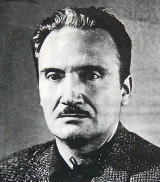 Antonio Melis says of the Peruvian writer José María Arguedas, "To begin with, the writings of Arguedas should be considered as an integrated totality (i.e. without the constraint of barriers such as genre)" (xi). This is indeed a good place to start: with a project to read the whole of Arguedas's writing, from the anthropological writings to the novels, from the poetry to the literary criticism, as constituting a whole life's work.
Antonio Melis says of the Peruvian writer José María Arguedas, "To begin with, the writings of Arguedas should be considered as an integrated totality (i.e. without the constraint of barriers such as genre)" (xi). This is indeed a good place to start: with a project to read the whole of Arguedas's writing, from the anthropological writings to the novels, from the poetry to the literary criticism, as constituting a whole life's work. "It goes without saying," continues Melis, "that there are continuous and fertile exchanges between Arguedas's ethnoanthropological investigations and literary creations, exchanges that open the way to fruitful and reciprocal illuminations" (xi).
Ciro Sandoval makes a similar point about "the extraordinary cultural intertextuality called for when reading Arguedas":
It is arbitrary, therefore, to study Arguedas's literary work as independent or disconnected from his work as ethnographer, folklorist, translator, and interpreter of legends, myths, songs, and especially from his deep preoccupation with the study of autochthonous creativity and culture. If Arguedas is important, it is because he attempted a sociology of art and culture through literary, anthropological, ethnographic, linguistic, and folkloric venues. All these endeavors simultaneously unfold in Arguedas and mutually complement and interconnect at different levels. (xxxiii)This is not to discard the question of genre completely. Rather, we should understand Arguedas's various incursions into different generic models as strategic interventions, a continuous process of experimentation, by which he attempted ever-new approaches towards the same fundamental problems that concerned him.
Arguedas's shift between genres, and his propensity to mix them up and crosspollinate them, introducing for instance to his novel Los ríos profundos chapters taken verbatim from his anthropological research, is not some exercise in writerly virtuosity. It's a sign of his profound dissatisfaction with all the genres available to him. More fundamentally, it's a sign of his dissatisfaction with writing, and indeed with language itself.
As Sandoval goes on to argue:
Arguedas's life and work represent a drama of the unspeakable, of the undecidable, of the culturally and linguistically untranslatable, a drama that began for him as a struggle with language [. . .]. (xxxiii)Arguedas's lifework was an attempt to formulate something like a subaltern aesthetics, to translate, incarnate, or record in written, linguistic form a subaltern poiesis.
Arguedas, better perhaps than any other Latin American writer, reveals and explores the problem of subalternity's relation with representation. Nobody was more aware of the fact that the subaltern cannot speak, of the ways in which the Andean world lies outside of, and excluded from, Western frameworks of representation. Nobody was more agonized by the fact that portrayals of the indigenous, from the conquistadors' chronicles to liberal indigenism, always entailed a silencing and occlusion of any hope for subaltern self-expression.
None of which is to imply that the subaltern is mute: Arguedas celebrates and documents both the cultural creativity of (particularly) Quechua song and folklore, and also the force of a kind of collective murmur, the semi-audible rumours that circulate like water through any highland crowd (or multitude), at the same time as he indicates how that fluency and fluidity is broken in its translation to Spanish.
In the first place, then, Arguedas's numerous switches between genres register that brokenness: his work is indeed a "totality," as Melis suggests, but a totality that is fractured, perhaps (Arguedas fears) irredeemably so. But it was the hope that some redemption might be possible that kept him going for as long as he did.
No comments:
Post a Comment